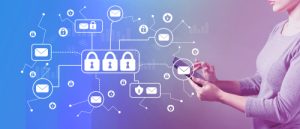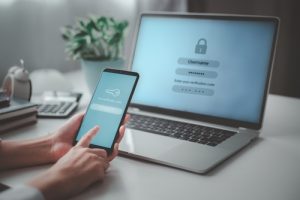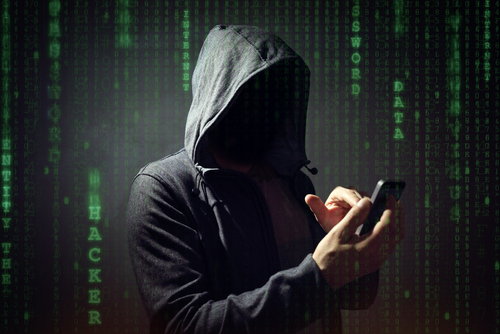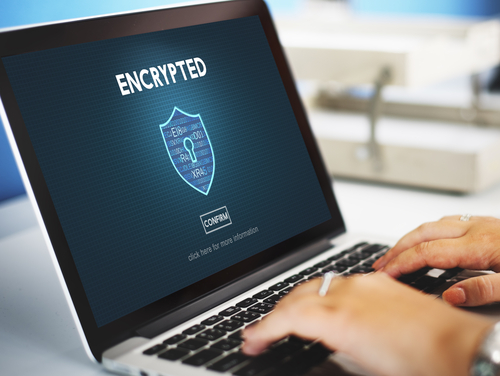Every business owner knows emails are an easy way to communicate with their employees and clients. However, emails also pose threats to your business’s online security.
Phishing scams and malware attacks can cost a business a lot of money. So, how do you get your employees to use best practices for email security? First, as a business leader, you need to create a secure environment for emails in your organization.
Then, you can establish a privacy policy and train your employees on the 9 email security best practices. Read on to learn how you can improve email security at your small business. Once you’ve educated your employees, you will see fewer data loss due to email cyberattacks.

How Can Email Security Best Practices Can Improve Your Business?
In 2021, the Federal Trade Commission (FTC) reported a more than $5.8 million loss due to fraud. The average data breach costs a company in the US approximately $9 million. More shockingly, these scams often took around 200 + days for the company to identify the data breach.
These statistics show that fraud, which is often conducted through phishing emails, can be devastating for a company. You need to protect your company’s, employees’, and clients’ sensitive information from being stolen by hackers. So, how can you do that?
Email security best practices are a set of guidelines that organizations and the employees within them can use to improve the safety and security of their email communication. These best practices will help your company to reduce the number of vulnerabilities it has. Then, you will have to deal with fewer data breaches and malware attacks, which will save your company money.
In addition, customers prefer companies that prioritize their internet privacy. If your employees use these best practices for email security, it will improve your customer’s privacy and build trust in your company.
Email Security Best Practices for Business Leaders
The CISA noticed in 2021 that cybercriminals are “shifting away from big-game” hunting in the United States.” This means that mid-sized companies were becoming the targets because middle to small-sized companies typically had fewer security best practices in place.
Oftentimes, these targets, called spear phishing, send an email with an attachment or link targeted at specific individuals within an organization. The information will be specific to the target that the cybercriminal gathered from social media or general knowledge about the company.
They’ll impersonate something the target trusts and ask the target to click on the link or attachment. Once you click that email attachment or link, ransomware or malware will download. Or it will ask for personal information. Then, the cybercriminal will get access to your login information, PINS, and more, putting the business at risk.
So, if you are a business leader and want to protect your company from email cyberattacks, there are some ways you can build an infrastructure to improve your company’s cybersecurity.
Monitor Your Company’s Email Activity
Either you or the IT managers in your organization need to keep track of who is sending and receiving emails through your business email accounts. Using security tools that provide you with analytics will help you with any email threats.
If a sudden change appears in email activity, this could be indicative of a cyber threat. This type of monitoring invades employee privacy, but employees should practice more caution when using a company email, as it puts the entire organization at risk.
Letting your employees know that you monitor their email activity will encourage them to use their best email security practices while using their business email accounts.
Use Encrypted Connections
Another way to secure email is to use encrypted connections while sending your emails. This helps to prevent attacks while the email is in transit. These encrypted connections, or Secure Sockets Layer/Transport Layer Security (SSL/TLS), protect data as it transmits from your computer to an email server.
An SSL certificate verifies that the content you are accessing is from the correct sender. To get an SSL certificate, do some research to find a reputable provider, then pay for the service and install it on your server. An alternative way for a business to secure their email messages during transit is to get a Virtual Private Network (VPN).
A VPN creates an encrypted tunnel that keeps hackers from intercepting data in transit. It works by taking the DNS request of the individual and rerouting it to a different server. This masks the individual computer’s IP address.
In fact, in today’s business where a lot of work is conducted in remote locations, a VPN can ensure security for all workers.
Install Antivirus Protections on All Devices
You must also install anti-malware, firewall, and antivirus software onto your computers. These also need to be up to date so that they work efficiently. Hackers use malware as part of their phishing attacks. First, they send an email with the malware attached.
An employee clicks on a link or opens attachments. Now, the malware downloads on your computer. Hackers use software embedded in malicious emails to steal your data and spy on you. However anti-malware software can help to stop these harmful programs before they infect your computer.
To ensure the safety of your business email, make sure the operating system, web browser, email client, and antivirus program are all updated regularly. Cybercriminals exploit any weaknesses to gain access to your sensitive data.
You can set your programs to automatic updates for more ease, but it is still important to do a check occasionally, to make sure they are updating properly.
Train Your Employees
One of the best ways to ensure your employees use email best practices with corporate email is to train employees in security awareness.
Many employees just need to be reminded of these security tips; others may not know that some of their actions pose security risks for the company. Awareness training goes a long way in building the expectations for security and privacy for your small business.
9 Email Safety Best Practices for Employees
Below, we will go over 9 email safety best practices that you can discuss with your employees to increase your email security measures in your small business.
#1 Create Strong Passwords
One of the greatest weaknesses of emails is a weak password. People are fallible and typically prefer to go for an easy-to-remember password rather than a secure one. The problem with simple passwords is that a hacker can use a brute force attack or gather just a little public knowledge about you to discover these passwords.
Even if you do create a unique password, you will want to use a different password for different accounts. So, if you use the same password for your work and personal email, if one gets compromised the other becomes more vulnerable to attack.
A complex password should be at least 12 characters long with a mixture of upper- and lower-case letters. There should also be numbers and special symbols included. Try to avoid things like your birthday as part of your email, as this is easy-to-find information.
Social engineers recommend changing your password regularly. How often is up for debate, but the typical length is somewhere between every 30 to 90 days. If you are worried that you’ll never be able to keep up with all those passwords, you can invest in a password manager that will remember all your passwords for you.
Some will even suggest ways for you to improve your passwords and remind you when it’s time to refresh old ones.
#2 Never Give Out Your Password
Although it may seem obvious, it is important to remind employees to avoid giving out their passwords. They may do this innocently, but even people within the company could pose a security threat. So, it is important to emphasize that you should not share your email with anyone, including coworkers, especially through email.
Someone could be posing as another person via email to trick you into giving out that information.
#3 Don’t Click Links
You should also never open attachments or click links until you are 100% sure that the sender is legitimate. Most phishing scams are successful because people are in a hurry and don’t verify the sender as they should. These scams are meant to make the recipient feel a sense of urgency.
Many email scams look like a trusted website or service, like Microsoft, asking you to reset your password due to unauthorized access. Unfortunately, the links and attachments inside these email scams are meant to harvest sensitive information. Once you input your username and password, you have given out this information to the cybercriminal.
Attachments can carry malware that steals your data and infects your computer, so it is important to verify the identity of the sender before clicking on any links or downloading any attachments.
#4 Know the Signs of a Suspicious Email
To better protect your email communications, it is important to understand what email spoofing looks like. Email scams can be very clever, and the con artists are getting more sophisticated, but general signs of a suspicious email include the following:
- Vague or no subject line
- Spelling errors and grammatical mistakes
- Unfamiliar tone or greeting
- Inconsistencies in email addresses
- Sense of urgency or threat
- Attachments with .zip, .exe., .scr
- Short
- You did not initiate the conversation.
- Requests credentials, payment, or personal information
- Unusual requests
If you suspect an email may be a phishing scam, contact the sender through another mode of communication like a messenger app or phone call to verify whether they sent the email or not. This simple extra step can save you from a cyberattack.
#5 Don’t Conduct Personal Email Communication on Work Email
People have separate personal and business emails for a reason. When you use your business email, you should follow certain professional conformance rules to make sure you represent the company well. When you conduct personal communications on a business email, you can accidentally compromise your company with your personal activities.
For example, you may send the wrong information to a personal contact, which could compromise your company. Also, if you subscribe to services and newsletters, you may put your corporate email at higher risk of malicious links and spam.
You should keep all your personal business in a separate email and save your company email for your business communications.
#6 Remember to Log Out on Shared Computers
If you work as part of a team that shares the same computer, you must log out of your accounts each time. Not every coworker is honest; some will even take advantage of this opportunity to spy on your emails, mess with your account, or gather data.
So, be sure to remember to log out of all your accounts on shared computers.

#7 Enable Two Factor Authentication
A great way to add another layer of security to your email account is to enable multi-factor authentication (MFA). MFA makes it harder for hackers to get access to your accounts. Even if they have your password and login information, MFA sends out a single-use passcode to a device like your mobile phone that is on your person.
If you receive this one-time code and you did not initiate the login, you know that a scammer knows your username and password. Then, you can change this information to stop the criminal in their tracks.
#8 Encrypt Emails
Email encryption is a must if you are sending personally identifiable information across the internet. Some professions, such as medicine or law, send out this information often. In these cases, emails can be targets for hackers.
Encryptions take the content of your message and scramble it, so it is impossible to read. Then, the message travels to the recipient who decrypts the message using either a public or private key, based on the type of encryption you use.
If you deal with sensitive information, it might be helpful to learn how to send an encrypted email to protect your employees’ and clients’ data.
#9 Don’t Access Emails on Public Wi-Fi
Finally, make sure that you avoid checking your business emails on public Wi-Fi networks. Or, if you do, use a VPN to secure your connection. Public Wi-Fi is open to anyone, and cybercriminals can lurk, creating a fake hotspot for you to connect to. Then, they steal your data.
Alternatively, it’s also easy for cybercriminals to intercept your emails on public Wi-Fi because these networks have few barriers against this type of activity. It’s best to use a VPN or Proxy server if you need to send an email in public to encrypt your data. Or avoid using business email in public spaces for even further protection.
Sekur Can Help Your Business
If you are looking for a more secure email service, Sekur can give your business more privacy. We have encrypted Swiss-hosted email, VPN, and instant messaging. All your data is transferred in a multi-layered 2048-bit encrypted tunnel to keep your communication safe.
You can send encrypted emails to recipients outside our Sekur network and have them reply within our Sekur environment. You can also use our service to monitor email activity. We have an easy email migration tool that makes switching simpler.
You can also send unlimited-size attachments. Try out Sekur today to regain your business’s privacy.
Conclusion
If you are a small to midsize business looking to train your employees in the best email security practices, try out these 9 security tips to improve your company’s email habits. If everyone is more mindful about their email activities, it can make a world of difference and help protect the company from phishing scams.

